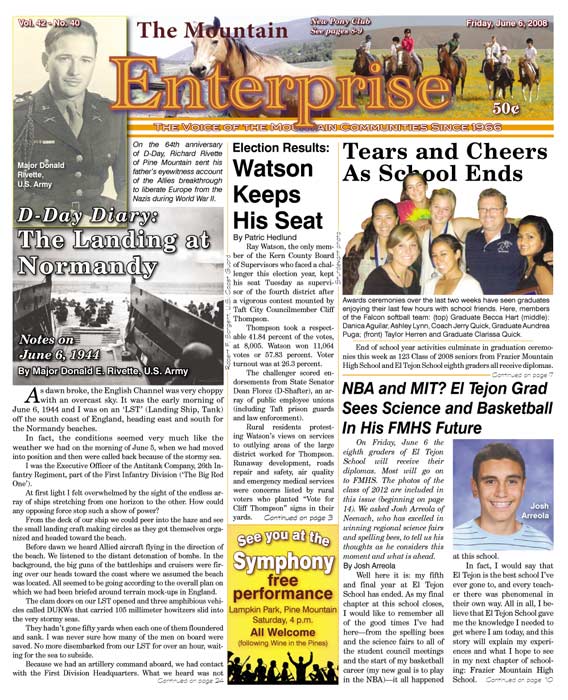By Patric Hedlund
UPDATE: FRAZIER PARK Calif. (Saturday, June 7, 2008)—A group of 11 scientists, condor biologists and members of the U.S. Fish and Wildlife Service Condor Recovery Team responsible for bringing the species back from the brink of extinction released a letter today, addressed to Governor Arnold Schwarzenegger. They cite the USFWS’ own research studies, along with those of the California Department of Fish and Game that say the survival of the largest land bird in North America is dependent on the area designated as Critical Habitat being preserved. Tejon Ranch Company (TRC) intends to build Tejon Mountain Village in the "core" of the condor’s Critical Habitat area the letter says.
A two-year secret negotiation between five conservation groups and TRC yielded an agreement announced May 8 for a phased, multipart preserve that could eventually retain 240,000 acres of the 270,000 acre ranch as contiguous habitat for many of the 28 animal and six plant species that live there which are labeled as threatened or endangered .
The agreement, announced with fanfare and a visit from the governor, has been hotly criticized by some California condor scientists because in return for the preservation plan, the conservation groups were required to agree to be sidelined and not participate in upcoming CEQA proceedings or to oppose three TRC developments: Tejon Mountain Village (3,400 homes and several resort hotels within the condor’s Critical Habitat), the Centennial project (23,000 homes and commercial-industrial parks) plus additional development adjacent to the Tejon Industrial Complex at the northern base of the Grapevine.
Further disclosures, reported by Associated Press last week, revealed that Tejon Ranch Company has made significant payments to condor scientists for their "opinion" on the TRC conservation plan. The payments were said to require the scientists to sign a contract agreeing not to oppose the company’s development plans, even if they feel the plans may harm the condor’s chances for survival. The arrangement have been called "buying silence" by those opposed to the TRC developments.
Concern has been raised that perhaps there would be no California condor expert voices left to speak honestly in the upcoming public process about the development proposals’ impact on the endangered species that has drawn the most sustained public and private involvement in America.
The June 7 scientist group’s full statement can be read below, following a statement from Tejon Ranch Wednesday, June 4 about their conservation plan.
FRAZIER PARK, Calif. (June 4, 2008) — Tejon Ranch today issued a statement emphasizing the ranch’s positive impacts for protected species within its proposed development areas and rebuking those who characterize the plan as a "license to kill condors." The full text of the statement follows.
————————————————————————–
Tejon Ranch Statement Regarding the Tehachapi Uplands Multi-species Habitat Conservation Plan
Lebec, Calif. (June 4, 2008) – The publication in the Federal Register today of a new Notice of Intent regarding the Tehachapi Uplands Multi-Species Habitat Conservation Plan (TUMSHCP) includes significant refinements that speak to the care Tejon Ranch and Tejon Mountain Village are taking regarding species protection
First, the proposed Tehachapi Uplands Multi-Species Habitat Conservation Plan, which would require the approval of the U.S. Fish and Wildlife Service, provides comprehensive protection for 34 different species of plants and animals that inhabit the Tehachapi Mountains. Because these species might be found on Tejon Ranch, we believe a Multi-species Habitat Conservation Plan on the Ranch is the best way to assure their on-going protection.
Secondly, the NOI states that Tejon Ranch is not seeking a lethal take permit for the condor. The characterization by some of the TUMSHCP as “a license to kill condors” is therefore inflammatory and false. And lastly, the new NOI makes it much clearer that hunting is not classified as a “covered activity” under the MSHCP.
__________________________________________________________
STATEMENT FROM CONDOR EXPERTS
Tejon Ranch Conservation Agreement: A Tragedy for Condors
From: Dr. Noel F. R. Snyder, David A. Clendenen, Janet A. Hamber, Dr. Eric V. Johnson, Dr. Allan Mee, Dr. Vicky J. Meretsky, Bruce K. Palmer, Anthony Prieto, Dr. Arthur C. Risser, Jr., Fred C. Sibley, and William D.Toone
Date: June 7, 2008
To: Governor Arnold Schwarzenegger
State Capitol Building
Sacramento, CA 95814
Assemblymember Pedro Nava
P.O. Box 942849
Sacramento, CA 94249
Kern County Board of Supervisors
1115 Truxtun Ave., 5th floor
Bakersfield, CA 93301
Ken McDermond
Deputy Regional Director, California Nevada Region
U.S. Fish and Wildlife Service
2800 Cottage Way, Room W-2605
Sacramento, CA 95825
Re: Tejon Ranch Conservation Agreement: A Tragedy for Condors
Dear Sir(s) and Madam(s):
At a press conference on May 8, several environmental organizations celebrated a deal with the Tejon Ranch Company that calls for permanent protection of large amounts of open space in exchange for a pledge from the organizations to not oppose Tejon’s proposed housing developments. But although they called the agreement a “great conservation achievement,” these organizations neglected to mention that one of the residential developments, Tejon Mountain Village, would place thousands of dwellings in the heart of officially designated “Critical Habitat” for the endangered California Condor.
As former and present participants in the condor conservation program we are firmly opposed to any development proposals for condor Critical Habitat, and we know of no evidence to support claims that the recent agreement is generally endorsed by condor experts. In fact, the agreement is almost uniformly opposed by condor experts who are independent of compensation from Tejon Ranch. Proponents have misrepresented the agreement by not revealing these negative aspects to the public, a problem we try to remedy here.
If built, this development would result in substantial harm to condors, posing a significant threat to the recovery of this well known and highly revered species. That any environmental organization might agree to such consequences is alarming and raises troubling questions about how the recent agreement was reached.
Critical Habitat, established on the Tejon Ranch in 1976, is the highest level of federal protection given to areas most crucial for endangered species and is designed to prevent significant degradation of these areas. The lands involved were a major focus for foraging and roosting activities and served as a hub for movements of condors throughout their range.
The recovering condor population is again occupying Critical Habitat on Tejon with frequency, and it is questionable that a fully satisfactory recovery of the species can be achieved in its historic range if significant degradation of these lands is allowed. Condors are sensitive to many direct and indirect threats from human activities and they uniformly avoided urban and suburban areas in historical times. A major housing development in the heart of one of their most important use areas simply should not be permitted.
Incredibly, private environmental organizations with no special authority and with very limited experience with condor issues have now agreed to a deal that would allow substantial residential development of condor Critical Habitat. Sadly this deal was based on secret negotiations from which virtually all experienced condor experts were excluded. This is the worst sort of deal-making imaginable, particularly for a species that has become a public trust.
The lands sacrificed in this agreement are of major and likely irreplaceable value to condor conservation, while many of the lands slated for protection have not normally been used by condors and likely will never be of importance to condors. Furthermore, many of the protected lands would likely never be developed because of steep terrain and other practical problems.
Unfortunately, in their eagerness to protect such lands a few well-meaning organizations have become parties to a major threat to condor conservation. They seem not to recognize that the price being paid for formal protection of undeveloped lands, some of them undevelopable, represent a huge net loss for conservation.
Critical Habitat designation has the force of law and deserves the respect and support of all parties, including land owners, governmental agencies, and environmental organizations. The recently announced plans are fundamentally inconsistent with Critical Habitat protection for the condor. If implemented, they would set a precedent for disregard of Critical Habitat protection for many other endangered species, a precedent with far-reaching and potentially disastrous consequences.
Tejon has many developable areas that lie outside Critical Habitat for condors, and surely the ranch could restrict its development plans to such locations if it were serious about its support of condor conservation. Unfortunately, such support has been in doubt since Tejon sued the U.S. Fish and Wildlife Service in the mid 1990s to remove endangered species protection from released condors and to prevent condor restoration efforts in the vicinity of the ranch. The lawsuit failed in the first respect but succeeded in the second, and no releases have been conducted in the near vicinity of Tejon.
The importance of Critical Habitat on Tejon Ranch to the California Condor has been repeatedly recognized in historical USFWS and CDFG documents and official statements, and has not diminished today. Some examples follow:
It is the opinion of the recovery team that the condor’s survival would be severely
jeopardized by any major change in the use and/or management of the core
portion of the Tejon Ranch (U.S. Fish and Wildlife Service 1979)
The condor will not survive without Tejon (in litt., U.S. Fish and Wildlife Service,
November 10.1971
…the ranch is one of the most important links in the preservation of this
endangered species (in litt., California Department of Fish and Game, May 21,
1979)
[Tejon Ranch}…is essential to condor survival and without it value of the Sespe
area would be questionable (U.S. Fish and Wildlife Service 1972)
The future of the California condor could hinge on maintaining the Tejon Ranch
habitat (U.S. Fish and Wildlife Service 1972)
It would be disastrous to have any major new developments very far inside the red
line [central portion of the Tehachapi Mountains] (in litt., U.S. Fish and Wildlife
Service, June 7, 1979)
I am mainly concerned about permanent or long term disturbances, or major
changes in the level of human activites. Homesites or ongoing mining activities,
for example, I feel would be incompatible with proper condor management (in
litt., U.S. Fish and Wildlife Service, June 7, 1979)
Allowing Tejon Mountain Village to be built in condor Critical Habitat would represent a victory only for unnecessary trophy-home development in the wrong place. This development would be a sad defeat for a species in which society has invested tremendous conservation resources, and an even worse defeat for the future of Critical Habitat protection for all endangered species.
These are no grounds for celebration.
Sincerely,
Dr. Noel F. R. Snyder
USFWS biologist in charge of condor field studies 1980-1986, member of Condor Recovery Team 1980-1985
P.O. Box 189
Portal, AZ 85632
(520) 558-2413
David A. Clendenen
Condor researcher and USFWS lead biologist for condors 1982-1997, member of Condor Recovery Team 1995-2000
Janet A. Hamber
Condor biologist, Santa Barbara Museum of Natural History, 1976-present
Dr. Eric V. Johnson
Field condor researcher, Cal Poly San Luis Obispo, 1978-1986
Dr. Allan Mee
Postdoctoral condor researcher for Zoological Society of San Diego 2001-2006
Dr. Vicky J. Meretsky
Field biologist, Condor Research Center 1984-1986
Bruce K. Palmer
USFWS California Condor Recovery Program Coordinator 2000-2004
Anthony Prieto
Co-founder of Project Gutpile and condor field biologist 1999-present
Dr. Arthur C. Risser, Jr.
Condor Recovery Team member 1980-1985
Fred C. Sibley
USFWS biologist in charge of condor field studies 1966-1969
William D.Toone
Condor Recovery Team member 1984-1992
This is part of the June 06, 2008 online edition of The Mountain Enterprise.
Have an opinion on this matter? We'd like to hear from you.


